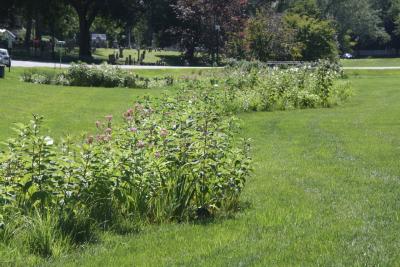The Bioswale in Full Bloom

Almost one year ago, the construction of a bioswale, a drainage course designed to trap pollutants and silt from surface runoff, started on the green north of Town Pond in East Hampton Village. The objective was to improve the water quality of Town and Hook Ponds.
This month, the plantings that make up the bioswale are in full bloom, and residents and visitors alike have taken notice — as have bees and butterflies.
Extensive stormwater runoff accumulates at the village green, which overflows into Town Pond and from there to a feeder stream of Hook Pond via a culvert. Both ponds also suffer from accumulated sediment, wastewater discharge, and nitrogen sources including fertilizer, waterfowl waste, and atmospheric deposition. Elevated levels of nitrogen and phosphorus promote harmful algal growth, which in turn depletes dissolved oxygen.
The bioswale intended to mitigate these conditions was planted to flower heavily at this time of year, said Tony Piazza of Piazza Horticultural in Southampton, who designed and installed it in partnership with the village and the Ladies Village Improvement Society. Mr. Piazza is a member of the eastern Long Island chapter of the Surfrider Foundation, a nonprofit organization dedicated to protecting oceans and beaches.
Hibiscus, swamp milkweed, blue flag iris, assorted native grasses, and assorted native shrubs were selected, Mr. Piazza said. “They’re plants that are typically found in a buffer zone at the end of a wetland, and they can handle periods of extreme wet, and then dryness in the summer,” he said. They also create physical barriers to capture sediment and leaves, “and that’s very evident on the village green.”
The bioswale is weeded every three weeks to help the plantings establish themselves. “The plants need a little extra help, but eventually they’ll crowd out everything and take over,” Mr. Piazza said. “The plants there are very well suited for the site. They’ll become the aggressor, rather than the weeds.”
On a site visit last week, the milkweed was covered with monarch butterflies, he said. “I was shocked to see honeybees and other pollinating bees. It’s a nice food source in an area where there wasn’t anything for years.”
